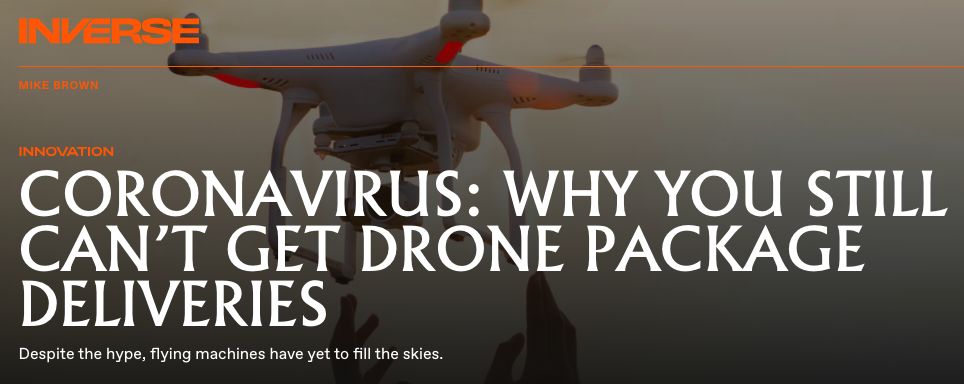CORONAVIRUS: Why you still can’t get Drone Package Deliveries?
This interview was originally posted on Inverse
Despite the hype, flying machines have yet to fill the skies.
Is it a bird? Is it a plane? Chances are it’s one of the two, as the fabled drone has yet to take off in a particularly big way. As the world grapples with the coronavirus pandemic, it seems a perfect opportunity to let these flying machines soar – so why aren’t they filling the sky?
“Primarily because the regulatory framework, globally, is still evolving,” Amit Ganjoo, board member for the Global UTM Association and CEO of ANRA Technologies, tells Inverse.
Drones, also known as unmanned aerial vehicles, could offer a multitude of benefits to populations looking to fight the coronavirus. They could be used to deliver packages to people self-isolating, saving delivery drivers from interacting with members of the public. Amazon outlined a drone delivery system back in 2016, which could offer 30-minute deliveries for products weighing less than five pounds.
UAVs could be used to transfer medical samples to laboratories. They could also be retrofitted with thermal scanners to check on a group, or with chemicals to help quickly clean a specified area. In a time of social distancing, pilot-less planes seem vital.
But while they seem a valuable contribution in the fight against the Covid–19 disease, their uses currently seem limited to enforcing national lockdown laws. A Global Times video shared in January showed Chinese authorities using drones equipped with speakers and cameras to call out citizens roaming the streets without a mask. Derbyshire Police in the U.K. shared drone footage of visitors to a local park this month, aimed at shaming those that may break lockdown laws. The latter post received strong criticism from followers.
Amid the outbreak, there are signs of more imaginative uses. The World Economic Forum earlier this month shared stories of how the Chinese government has piloted drone technology for use in three key areas. One is consumer deliveries, where hour-long road trips in Anxin County were cut down to just two kilometers in 10 minutes. A second is in aerial disinfectant sprays, which can offer 50 times greater efficiency than people spraying.
The third is in transporting supplies. Tests in this area have shown promise: in February, a drone flew two miles in Zhejiang province from a hospital to the Chinese Center for Disease Control and Prevention. The trip normally took 20 minutes, but by drone this was cut down to just six. The successful results pushed authorities to run 20 flights per day at its peak.
They seem great. So why can’t we use them more?
Ganjoo says it’s a question of regulation. In the United States, commercial pilots can fly UAVs subject to a large number of rules under Part 107. It’s a similar situation elsewhere: China’s trial of disinfectant operations required coordination from a dizzying array of agencies and associations.
Perhaps the most limiting rule in Part 107 is visual line-of-sight, where the pilot needs to be able to physically see the drone at all times of operation.
“I can do a package delivery today legally, as long as I fly a drone from my home to the house 10 doors down,” Ganjoo says, with the caveat that he would need a Part 135 commercial cargo license to charge for this fictional delivery. “But the main use case is when I’m going miles and miles away.”
The industry and regulators are working through these issues, and that poses a number of safety questions. What happens if the operator loses contact with the drone? How will it avoid obstacles? What about nighttime operations? Are there privacy concerns?
The global virus outbreak has sparked a radical reshaping of regulations in a short space of time. The British government has relaxed planning regulation to enable pubs to deliver, the British Retail Consortium has raised the limit on contactless card payments, and the United States’ Food and Drug Administration has rapidly altered its policy on testing to move faster on the outbreak. Drones seem ripe for reconsideration – but Ganjoo pours cold water on the idea.
“Besides running this company, I’m a pilot,” Ganjoo says. “The safety standards in aviation are very different and way higher than anything else. And they are for good reason. Because if something happens in the sky, I can’t pull over to the side of the road.”
The most that may happen, Ganjoo says, is that more teams receive approval for Beyond Visual Line of Sight operations, or BVLOS. A limited selection of firms are cleared for BVLOS at the moment. This includes BSNF Railways, which has used drones to monitor rail disruptions since 2015. However, TheNextWeb notes that of 1,200 applications submitted to the Federal Aviation Authority for approval, around 99 percent get rejected.
The pandemic could influence the frameworks over the long term, but Ganjoo says it’s unlikely that 10 new firms will receive BVLOS approval overnight.
Although the possibilities seem exciting, drones have somewhat suffered from too much hype. They may have useful real-world applications, but regulators aren’t going to fill the skies tomorrow.
“Drones are not going to be the panacea to everything,” Ganjoo says. “There may be situations where it’s easier to get on the bike and just go and deliver a sample.”
Drones may find their niche over time, but in some cases the simplest solution may remain the best.







